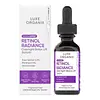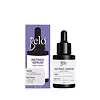What's inside
What's inside
 Key Ingredients
Key Ingredients

 Benefits
Benefits

 Concerns
Concerns

 Ingredients Side-by-side
Ingredients Side-by-side

Water
Skin ConditioningPanthenol
Skin ConditioningButylene Glycol
HumectantCaprylic/Capric Triglyceride
MaskingSodium PCA
HumectantPropanediol
SolventAmmonium Polyacryloyldimethyl Taurate
Emulsion StabilisingHydroxyacetophenone
Antioxidant1,2-Hexanediol
Skin ConditioningDimethyl Isosorbide
SolventPentylene Glycol
Skin ConditioningNiacinamide
SmoothingResveratrol
AntioxidantLactobacillus/Soymilk Ferment Filtrate
Skin ConditioningPolysorbate 20
EmulsifyingRetinol
Skin ConditioningAllantoin
Skin ConditioningPhenoxyethanol
PreservativeBHT
AntioxidantBHA
AntioxidantWater, Panthenol, Butylene Glycol, Caprylic/Capric Triglyceride, Sodium PCA, Propanediol, Ammonium Polyacryloyldimethyl Taurate, Hydroxyacetophenone, 1,2-Hexanediol, Dimethyl Isosorbide, Pentylene Glycol, Niacinamide, Resveratrol, Lactobacillus/Soymilk Ferment Filtrate, Polysorbate 20, Retinol, Allantoin, Phenoxyethanol, BHT, BHA
Water
Skin Conditioning1,2-Hexanediol
Skin ConditioningGlycerin
HumectantGlycine Soja Oil
EmollientDisodium EDTA
Hydrogenated Phosphatidylcholine
EmulsifyingDecapeptide-4
Skin ConditioningSodium Oleate
CleansingCellulose Gum
Emulsion StabilisingXanthan Gum
EmulsifyingInulin
Skin ConditioningCellulose
AbsorbentGlucose
HumectantFructose
HumectantPEG-12 Dimethicone
Skin ConditioningPhenoxyethanol
PreservativeEthylhexylglycerin
Skin ConditioningRetinol
Skin ConditioningUndecane
EmollientTridecane
PerfumingTocopherol
AntioxidantSodium PCA
HumectantPEG-40 Hydrogenated Castor Oil
EmulsifyingParfum
MaskingWater, 1,2-Hexanediol, Glycerin, Glycine Soja Oil, Disodium EDTA, Hydrogenated Phosphatidylcholine, Decapeptide-4, Sodium Oleate, Cellulose Gum, Xanthan Gum, Inulin, Cellulose, Glucose, Fructose, PEG-12 Dimethicone, Phenoxyethanol, Ethylhexylglycerin, Retinol, Undecane, Tridecane, Tocopherol, Sodium PCA, PEG-40 Hydrogenated Castor Oil, Parfum
 Reviews
Reviews

Ingredients Explained
These ingredients are found in both products.
Ingredients higher up in an ingredient list are typically present in a larger amount.
1,2-Hexanediol is a synthetic liquid and another multi-functional powerhouse.
It is a:
- Humectant, drawing moisture into the skin
- Emollient, helping to soften skin
- Solvent, dispersing and stabilizing formulas
- Preservative booster, enhancing the antimicrobial activity of other preservatives
Phenoxyethanol is a preservative that has germicide, antimicrobial, and aromatic properties. Studies show that phenoxyethanol can prevent microbial growth. By itself, it has a scent that is similar to that of a rose.
It's often used in formulations along with Caprylyl Glycol to preserve the shelf life of products.
Retinol is a gold-standard ingredient for anti-aging. It is a form of Vitamin A and belongs to the class of retinoids that also includes tretinoin.
Why is retinol famous?
It has the most scientific studies backing up its skin benefits out of all the non-prescription ingredients.
Retinol is proven to:
This is why retinol is effective at removing wrinkles, fading dark spots, treating acne, and reducing the appearance of pores.
Studies show retinol is less effective when exposed to UV. Be sure to look for appropriate packaging to keep your retinol potent (similar to Vitamin C).
Using retinol or any retinoids will increase sun-sensitivity in the first few months. Though studies show retinoids increase your skin's natural SPF with continuous use, it is best to always wear sunscreen and sun-protection.
We recommend speaking with a medical professional about using this ingredient during pregnancy.
Retinol may cause irritation in some people, so be sure to patch test. Experts recommend 'ramping up' retinol use: start using this ingredient once a week and work up to using it daily.
Read about Tretinoin
Learn more about RetinolSodium PCA is the sodium salt of pyroglutamic acid. It is naturally occurring in our skin's natural moisturizing factors where it works to maintain hydration.
The PCA stands for pyrrolidone carboxylic acid, a natural amino acid derivative.
This ingredient has skin conditioning, anti-inflammatory, and humectant properties. Humectants help hydrate your skin by drawing moisture from the air. This helps keep your skin moisturized.
Learn more about Sodium PCAWater. It's the most common cosmetic ingredient of all. You'll usually see it at the top of ingredient lists, meaning that it makes up the largest part of the product.
So why is it so popular? Water most often acts as a solvent - this means that it helps dissolve other ingredients into the formulation.
You'll also recognize water as that liquid we all need to stay alive. If you see this, drink a glass of water. Stay hydrated!
Learn more about Water